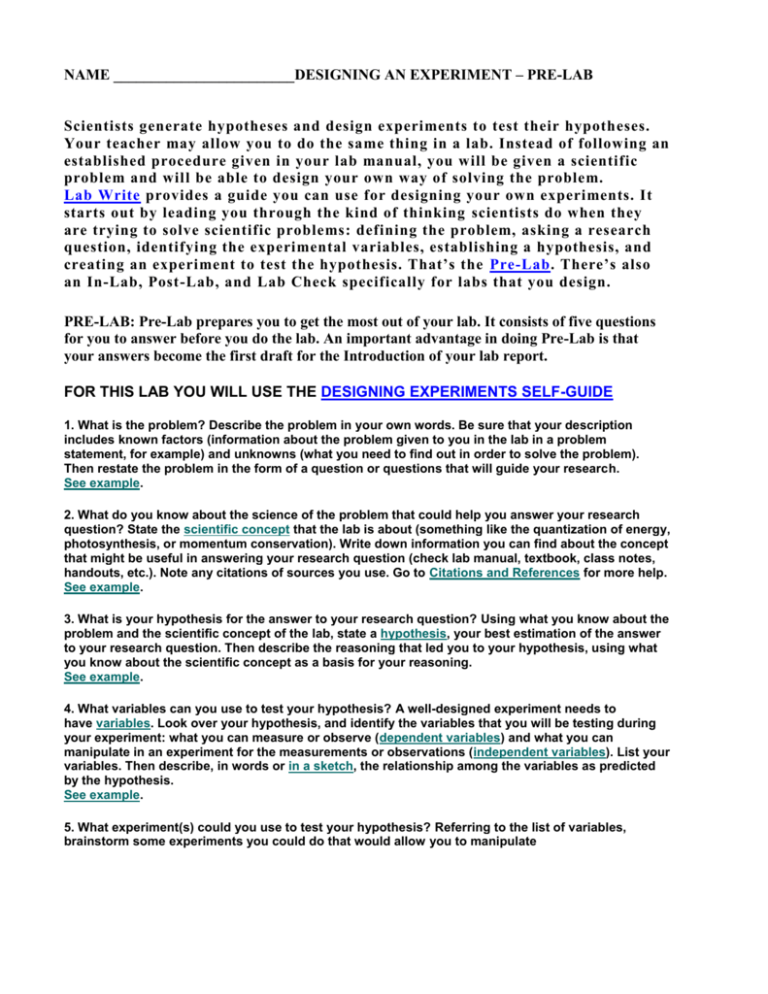Designing Your Own Lab Experiments Handout
advertisement

NAME ________________________DESIGNING AN EXPERIMENT – PRE-LAB Scientists generate hypotheses and design experiments to test their hypotheses. Your teacher may allow you to do the same thing in a lab. Instead of following an established procedure given in your lab manual, you will be given a scientific problem and will be able to design your own way of solving the problem. Lab Write provides a guide you can use for designing your own experiments. It starts out by leading you through the kind of thinking scientists do when they are trying to solve scientific problems: defining the problem, asking a research question, identifying the experimental variables, establishing a hypothesis, and creating an experiment to test the hypothesis. That’s the Pre-Lab. There’s also an In-Lab, Post-Lab, and Lab Check specifically for labs that you design. PRE-LAB: Pre-Lab prepares you to get the most out of your lab. It consists of five questions for you to answer before you do the lab. An important advantage in doing Pre-Lab is that your answers become the first draft for the Introduction of your lab report. FOR THIS LAB YOU WILL USE THE DESIGNING EXPERIMENTS SELF-GUIDE 1. What is the problem? Describe the problem in your own words. Be sure that your description includes known factors (information about the problem given to you in the lab in a problem statement, for example) and unknowns (what you need to find out in order to solve the problem). Then restate the problem in the form of a question or questions that will guide your research. See example. 2. What do you know about the science of the problem that could help you answer your research question? State the scientific concept that the lab is about (something like the quantization of energy, photosynthesis, or momentum conservation). Write down information you can find about the concept that might be useful in answering your research question (check lab manual, textbook, class notes, handouts, etc.). Note any citations of sources you use. Go to Citations and References for more help. See example. 3. What is your hypothesis for the answer to your research question? Using what you know about the problem and the scientific concept of the lab, state a hypothesis, your best estimation of the answer to your research question. Then describe the reasoning that led you to your hypothesis, using what you know about the scientific concept as a basis for your reasoning. See example. 4. What variables can you use to test your hypothesis? A well-designed experiment needs to have variables. Look over your hypothesis, and identify the variables that you will be testing during your experiment: what you can measure or observe (dependent variables) and what you can manipulate in an experiment for the measurements or observations (independent variables). List your variables. Then describe, in words or in a sketch, the relationship among the variables as predicted by the hypothesis. See example. 5. What experiment(s) could you use to test your hypothesis? Referring to the list of variables, brainstorm some experiments you could do that would allow you to manipulate Designing Your Own Lab Experiments Handout Pre-Lab: questions to answer before doing the lab Name: Date: Lab Title: 1. What is the problem? 2. What do you know about the science of the problem that could help you answer your research question? 3. What is your hypothesis for the answer to your research question? 4. What variables can you use to test your hypothesis? 5. What experiment(s) could you use to test your hypothesis?









